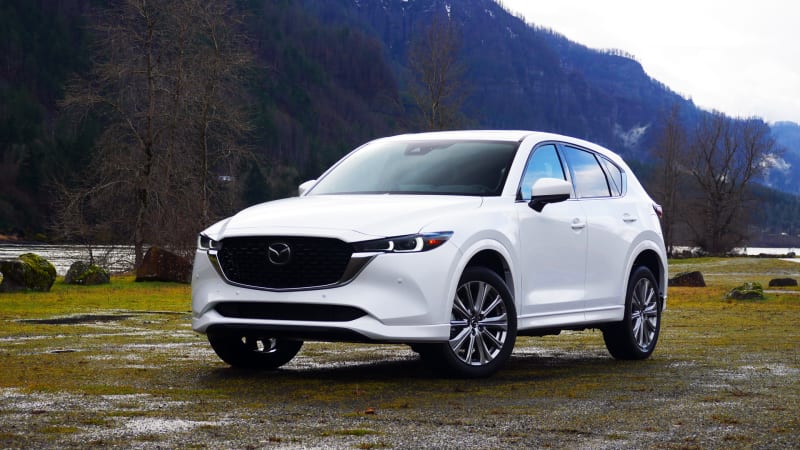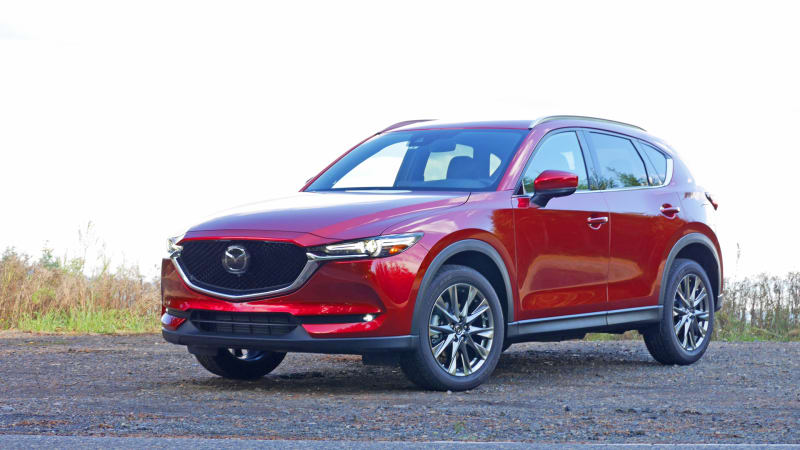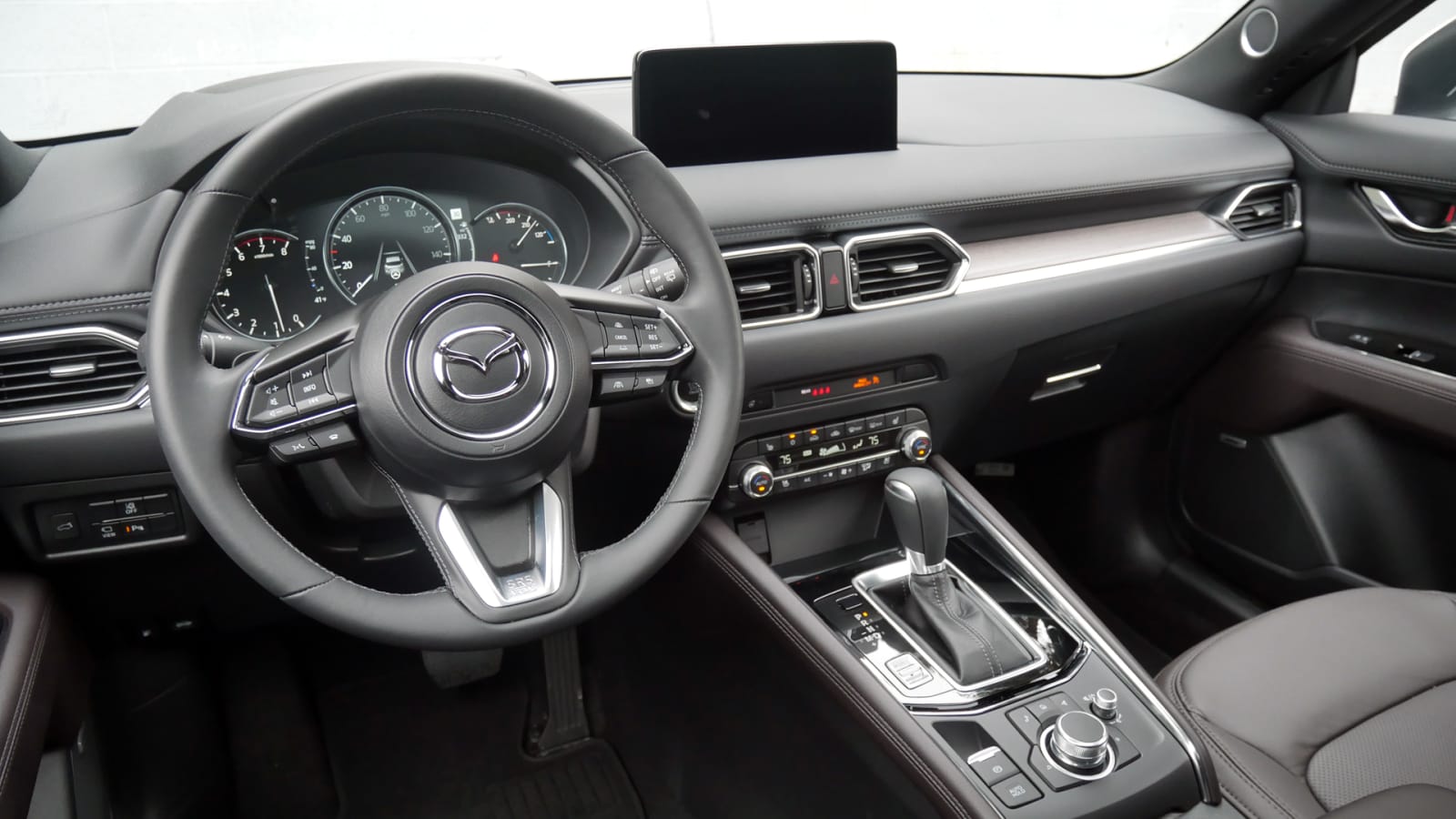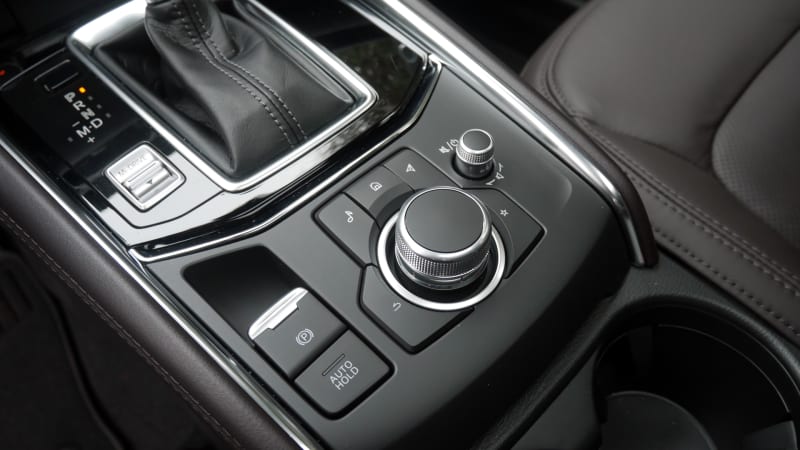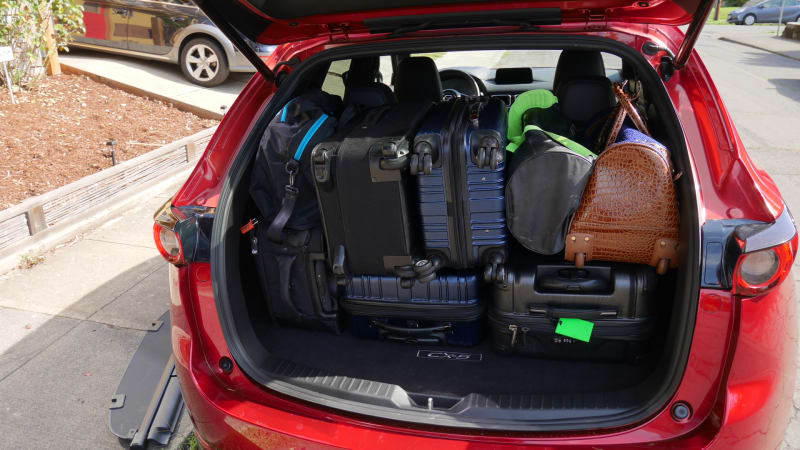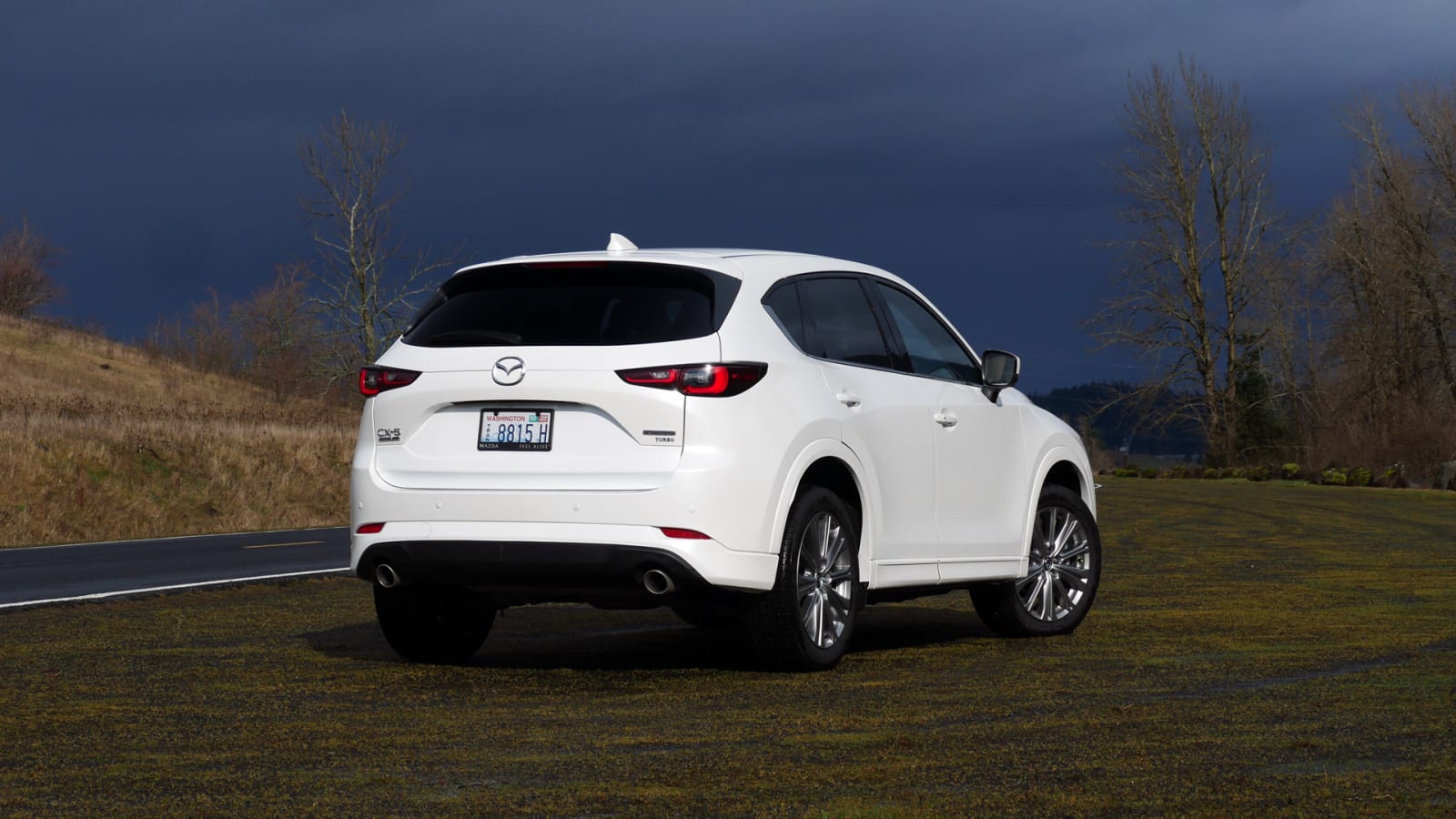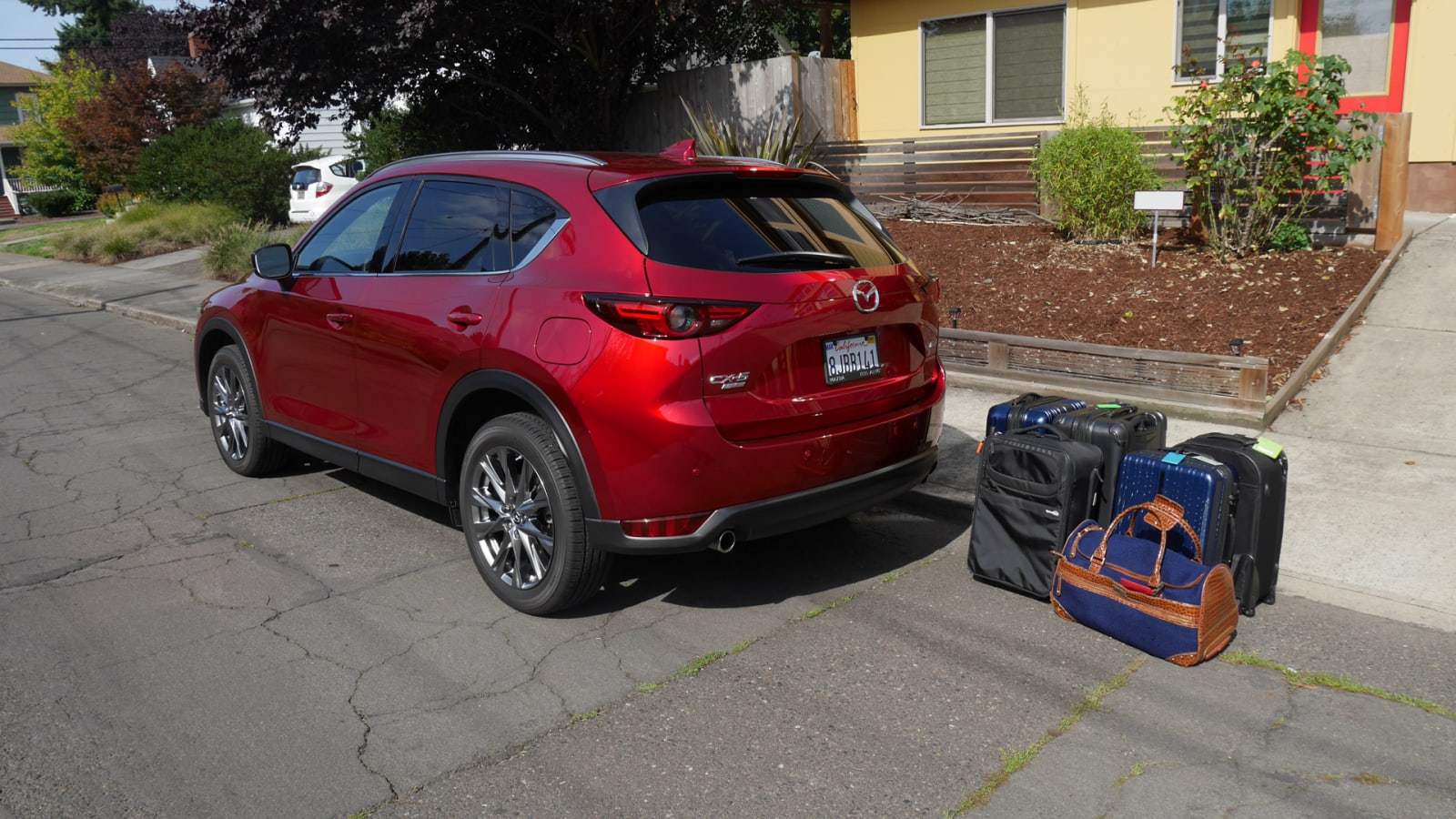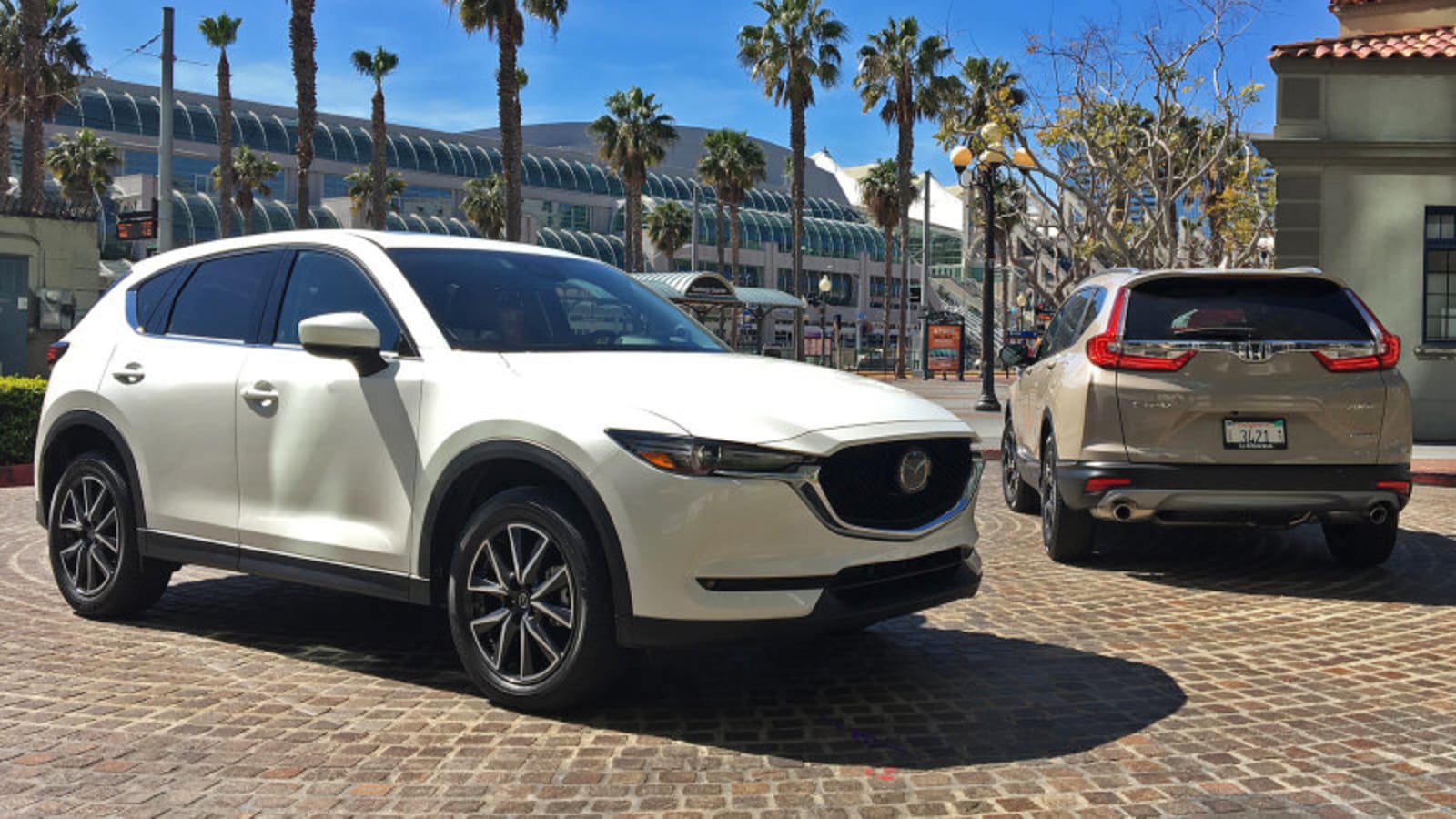As we see it, there are two main reasons to choose a 2022 Mazda CX-5 over any number of its many compact SUV competitors. First, you like the idea of sitting high and having some extra utility on occasion, but would happily trade max family-friendly utility for a higher-quality interior, sleek styling and a sharper driving experience. Basically, single folks, DINKs, empty nesters. Second, you are in need of a family-friendly vehicle, but you’re used to driving a smaller, more agile car and you’re dreading trading it in for a, gulp, family-friendly vehicle. We feel your pain.
If either of these sounds like you, then the CX-5 is a terrific choice, and indeed it’s one of our top-recommended compact SUVs. It’s great to drive, great to look at and in top trim levels, makes for a viable alternative to some luxury SUVs. It strikes an emotional chord in a way few competitors can. That said, it is smaller and less functional than the RAV4s and CR-Vs of the world. It’s also less efficient and doesn’t offer a hybrid powertrain. So, it may not check off every box, but for the right type of buyers, it doesn’t need to.
Interior & Technology | Passenger & Cargo Space | Performance & Fuel Economy
What it’s like to drive | Pricing & Features | Crash Ratings & Safety Features
What’s new for 2022?
Every CX-5 now comes standard with all-wheel drive, joining the Subaru Forester as the only vehicles in their segment to do so. The styling is also subtly updated for 2022, including new LED head- and taillight elements, a new three-dimensional grille insert surrounded by redesigned chrome trim, new bumper designs and larger dual tailpipes. The range-topping Signature, pictured here, gains body-colored lower body trim and fender flares. Those pieces remain black on all other trims. You can see the visual differences between the 2022 and 2021 above.
Changes were also made to the suspension and frame to reduce noise and vibration, and increase ride comfort. Transmission response was also improved and the available turbo engine produces more power when using 93 octane. The front seats were also redesigned. Finally, there are new trim levels for 2022.
What are the CX-5 interior and in-car technology like?
The CX-5 boasts a handsome, upscale design with materials to match, exuding a premium vibe that none of its direct competitors can match. Its top trim levels have seats that are heated all around and ventilated up front, plus high-quality leather with contrast French stitching. The Signature gets unique Catarra Brown Nappa leather, shown here. The padded and stitched pleather on the dash, doors and center console are a nice touch too, as is the alloy trim — especially the air vents that seem to jut out from within the dash. Admittedly, fancier touches like the Signature’s wood-look trim are absent on lower trim levels, but the overall interior ambience remains more premium and stylish than those of most competitors — especially something like the Toyota RAV4 and Subaru Forester that are going for more of a rugged, utilitarian vibe.
Mazda’s tech interface is distinctive in that it uses a center console knob controller rather than a touchscreen. This isn’t Mazda being behind the times, it’s a conscious effort to reduce driver distraction. The dashtop screen is large and easy to see while running a relatively simple and quick user interface. The knob that controls it is big, ergonomically placed on the center console and, like BMW’s iDrive controller, can rotate through menus or move up/down, left/right among icons. This latter feature is key for using Apple CarPlay and Android Auto, which is where the troubles begin. Both connectivity features are intended for a touchscreen and selecting their icons by rotating and clicking the knob is more time consuming and distracting. That said, wheeling through playlists or contacts is actually easier with a knob, and unlike most other manufacturers, Mazda doesn’t lock out those functions while the vehicle is in motion (good news for passengers).
How big is the CX-5?
The CX-5 is on the small end of the compact SUV segment. There is adequate space inside for four occupants to ride around in relative comfort, but families may find they could use the sort of extra space provided by the Honda CR-V, Hyundai Tucson and Toyota RAV4. Kids are more likely to end up kicking the front seats from front-facing child seats, and those up front are more likely to need to scoot their seats up to make room for rear-facing child seats.
The CX-5 has 30.9 cubic-feet of space behind its back seat, which is considerably less than those competitors. The Hyundai Tucson leads the way with 38.7 cubic-feet, the Honda CR-V (39.2) and Toyota RAV4 (37.5) are basically the same, and the Subaru Forester has between 33 and 35 depending on options. That said, the CX-5 does have more than the Chevy Equinox and Ford Escape, and in our luggage test, found it could hold five suitcases and three duffle bags. That’s a clear upgrade over various midcompact SUVs like Mazda’s CX-30.
What are the CX-5 fuel economy and performance specs?
Mazda CX-5 trim levels with 2.5 S in their name feature a 2.5-liter inline-four that produces 187 horsepower and 186 pound-feet of torque. A six-speed automatic transmission and all-wheel drive are standard. It’s a unique AWD system that monitors vehicle weight distribution among the usual factors of throttle position and current traction in order to improve response and handling. Fuel economy estimates are 24 mpg city, 30 mpg highway and 26 mpg combined. These are lower than the CR-V, Forester and RAV4, which fall in the 28-29 mpg combined range. The CR-V and RAV4, plus the Hyundai Tucson, also offer more efficient and highly recommended hybrid powertrains.
Trim levels with 2.5 Turbo in their name feature a 2.5-liter turbocharged inline-four good for 227 hp and 310 lb-ft of torque. It’ll do 256 hp on 93 octane if you live in a place that sells that and you feel like paying more for gas. Either way, this engine produces the sort of energetic acceleration that few others in the segment can match, including none of those competitors above. It too is paired with a six-speed automatic and all-wheel drive. Fuel economy drops further down to 22 mpg city, 27 mpg highway and 24 mpg combined.
What’s the CX-5 like to drive?
Mazda’s compact crossover is perfect for the person whose life changes have dictated the switch from an agile car to some sort of family hauler. Its spot-on steering and throttle response evoke Porsche, while the six-speed automatic transmission favors performance over fuel economy (while still getting relatively good mileage). Those dynamic elements, plus a carefully crafted, ideal driving position and the ample grunt from the available turbo engine should make the CX-5 feel “just right” for those used to more sporting, non-family-oriented transport. That said, its ride quality is on the firmer side. It’s never harsh, even with big wheels, but you certainly feel more of the road than in most competitors.
Part of its dynamic prowess comes from the fact that G-Vectoring Control Plus, technology exclusive to Mazda, uses engine torque to shift weight onto the front wheels just as turn-in is initiated. That provides more grip on the turning wheels, and while it’s most noticeable in poor road conditions, it further instills the driver with a calm assurance on the curviest of roads even when surfaces are dry. It can also apply the outside wheel’s brake, which guides the vehicle with the sort of smooth control typically reserved for sports sedans.
What other Mazda CX-5 reviews can I read?
2019 Mazda CX-5 Luggage Test | How much fits in the trunk
See how much luggage can fit in the CX-5’s cargo area.
2019 Mazda CX-5 Turbo Drivers’ Notes Review | More power, more love
Our first time driving the CX-5 Turbo’s engine. The car has been updated since then, but our overall impressions of the turbo engine remain the same.
Mazda CX-5 Pros and Cons Video
Senior Editor James Riswick shares his pros and cons of the CX-5 when it was all-new for 2017.
Honda CR-V vs Mazda CX-5 Comparison | A tough choice
Driving the CX-5 and CR-V back-to-back, comparing their driving experiences, interiors and specs. Both have been updated since this was written but our opinions remain broadly the same.
How much is the 2022 CX-5 price and what features are available?
Prices are up for 2022, but a $755 increase is still less than the old $1,500 option price for all-wheel drive, which is now standard. Otherwise, Mazda created an entirely new trim level structure, complete with new names for 2022, so it’s a bit hard to know how much really changed. At the very least, the range-topping Signature is only a few hundred more than its predecessor.
Base equipment for $27,125 includes a full complement of driver assistance tech (detailed below), alloy wheels, automatic headlights and wipers, cloth seating, a leather-wrapped steering wheel (rare among base trim levels), the 10.25-inch infotainment display, a four-speaker sound system, two USB ports up front, Apple CarPlay, Android Auto and a three-month/2GB trial of in-car WiFi. For an extra $2,000, the S Select is probably the best place to start as it adds rear privacy glass, auto-leveling lights, proximity entry, dual-zone climate control, leatherette upholstery, heated front seats with six-way power driver adjustment and manual passenger height adjustment, a six-speaker sound system and two rear USB ports.
From there, it’s really just a matter of slathering on niceties you could almost certainly live without. Some key items, though: the Carbon Edition is mostly an appearance package on top of the Preferred that adds black wheels and trim, unique Polymetal Gray paint and a red interior option. Sport and Off-Road drive modes also show up starting with the Premium, while the Turbo trims get slightly different styling and leather upholstery.
More information about each trim level’s features can be found here on Autoblog. All prices below include the $1,225 destination charge.
S: $27,125
S Select: $29,125
S Preferred: $30,385
S Carbon Edition: $31,505
S Premium: $33,535
S Premium Plus: $33,950
Turbo: $36,400
Turbo Signature: $38,650
What are the CX-5 safety ratings and driver assistance features?
Every CX-5 includes forward collision warning with automatic emergency braking and pedestrian detection, lane-departure warning, lane-keeping assist, adaptive cruise control, and blind-spot and rear cross-traffic warning systems. The latter two are usually found on the upper trim levels of competitors. The range-topping Signature adds automatic rear emergency braking, a driver inattention warning system and low-speed steering assist when using adaptive cruise control (Traffic Jam Assist).
The federal government gave the CX-5 top five-star rating for overall, frontal and side crash worthiness. It got a typical four-star rollover rating. The Insurance Institute for Highway Safety named it a Top Safety Pick+ for its best-possible ratings in all pertinent crash tests and for its accident avoidance tech. The CX-5 was also the only compact SUV, period, to get the best-possible rating of “Good” in the newer, tougher IIHS side crash test (it does not yet count toward Top Safety Pick qualifications).
Source: www.autoblog.com

